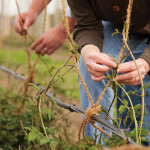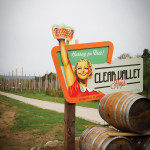Southern Georgian Bay is fast becoming one of the top hops growing regions in Ontario
by Emily Worts, photography by Kristie & Brenden Woods

Dozens of recycled hydro poles stand at attention, row upon row, on the west side of Highway 124 at the south end of Nottawa. In late spring into early summer the poles look naked to passersby, but creeping up their bases are tenacious and vibrantly green plants which will reach their full height of 20 feet in six short weeks, growing up to 12 inches a day in peak season. The small pine cone-shaped flower of the Humulus lupulus plant, commonly known as hops, will soon be harvested at Clear Valley Hops for both flavour and as a preserving agent in Canada’s national drink: beer. We can thank hops for the wonderful and distinctively bitter aromas and flavours we Canadians have come to love in our brew.
The land was cleared at Clear Valley Hops four years ago and planted acreage of hops has tripled to 13 acres since then. This year’s harvest is estimated at 12,000 pounds of hops, making Clear Valley Hops one of the largest independent growers in Ontario, if not the country.
“These are the freshest hops in the world,” says Laurie Thatcher-Craig, co-owner of Clear Valley Hops. Thatcher-Craig takes great pride in her hops, which are harvested and then quickly dried at a low heat, pelletized using a process to preserve the oil and lupulin of the hops, vacuum sealed and nitrogen flushed.
“We are producing world-class hops,” she maintains.
There are just shy of 50 acres of hops currently under production in Ontario, says Nicholas Schaut, past president of the Ontario Hops Growers Association (OHGA) and owner of Bighead Hops in Meaford. Schaut estimates that by the end of this year that number will grow to 80 acres, more than four times the amount grown in 2012. “It’s growing very quickly despite how much it costs to develop and create a hop yard,” says Schaut of the hops industry.
Hops yards have a long history in Ontario. By the nineteenth century, hop farming had become a thriving industry in Ontario and hop-pickers were paid about 30 cents per 13-pound box of hops, with an expert picker filling two in a day.
During the prohibition era the commercial hop industry all but dried up. The centralization and industrialization of the brewing process along with pest pressures on the hops plant didn’t help the industry, either. Ontario hadn’t seen a commercial hop yard in decades, until recently. A resurgence of the hops crop in Ontario started in 2007 due in part to a worldwide hop shortage but also because of the undeniable popularity of the local food movement, which meant an increased demand for locally made craft beers. Craft brewers, who are often progressive and conscientious and prefer to support high quality, and if possible, local products, use 10 times the amount of hops that standard brews like Labatt Blue use. “A number of us have multi-year contracts and intimate relationships with one or two breweries,” says Schaut of independent hops growers. “For the most part Ontario hops are staying local. Some of us who are larger may ship throughout Canada.”
Bighead Hops is the largest certified organic hops grower in Ontario, with five acres in production and another five on the way. With only a couple of certified organic hops growers in Ontario, Bighead receives requests from around the world, but there is such a demand here in Ontario and in Quebec, there is no need to ship abroad.
When Schaut helped found the OHGA six years ago he was supported by a small group of farmers. At the time there were only a handful of hops growers in Ontario. Today there are 28 growers producing commercial quantities of hops in Ontario with 26 affiliates, many of whom are planning to grow to commercial levels in the near future.
Over at Clear Valley Hops, 50 Russian Romanov sheep, borrowed from a neighbour’s farm, mow down the weeds growing between the 18 varieties of hops. Clear Valley Hops doesn’t grow average varieties of hops commonly used by larger scale brewers; they cultivate harder to find varieties and even a ‘new’ variety they’ve named Wild Turkey, which the owners found growing wild on their farm.
Thatcher-Craig admits it can be hard to sell the less traditional varieties of hops even to craft brewers, as their recipes depend so heavily on more common varieties, often patented, that can only be grown and purchased in the United States. In 2012, Canadian brewers imported $14 million worth of hops, with the United States and Germany as our largest suppliers.
“Craft breweries have to develop recipes, just like chefs who cook locally and seasonally, around these different varieties,” says Thatcher-Craig. The beer will taste different, she admits, but that doesn’t mean it won’t be delicious.
In many ways the hops industry is where the wine industry was four decades ago. Understanding the front end of production and the connection with the farmland, says Thatcher-Craig, is as important as understanding the craft of making beer. “We are providing that connection. There is a lot happening in this area. We all came in at the same time and we are all coming together,” she says of the local craft brewing industry that is taking off in Southern Georgian Bay.
Ontario has always been an ideal place to grow hops. So ideal, in fact, that it is not uncommon to find ‘feral’ hops growing, like the ones found at Clear Valley Hops, along broken-down cedar posts abandoned in the back fields of ancient farms. During prohibition, farmers were often asked to grow discreet patches of hops in their back 40 in exchange for a share of beer. Almost 100 years later these plants survive, a testament to Ontario’s hop growing history whose resurgence is pioneering a whole new era in Ontario’s craft brewing revolution. ❧




















